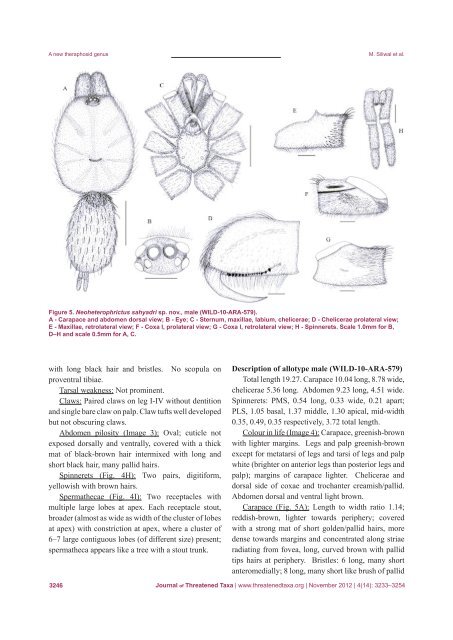View - Journal of Threatened Taxa
View - Journal of Threatened Taxa
View - Journal of Threatened Taxa
You also want an ePaper? Increase the reach of your titles
YUMPU automatically turns print PDFs into web optimized ePapers that Google loves.
A new theraphosid genusM. Siliwal et al.Figure 5. Neoheterophrictus sahyadri sp. nov., male (WILD-10-ARA-579).A - Carapace and abdomen dorsal view; B - Eye; C - Sternum, maxillae, labium, chelicerae; D - Chelicerae prolateral view;E - Maxillae, retrolateral view; F - Coxa I, prolateral view; G - Coxa I, retrolateral view; H - Spinnerets. Scale 1.0mm for B,D–H and scale 0.5mm for A, C.with long black hair and bristles. No scopula onproventral tibiae.Tarsal weakness: Not prominent.Claws: Paired claws on leg I-IV without dentitionand single bare claw on palp. Claw tufts well developedbut not obscuring claws.Abdomen pilosity (Image 3): Oval; cuticle notexposed dorsally and ventrally, covered with a thickmat <strong>of</strong> black-brown hair intermixed with long andshort black hair, many pallid hairs.Spinnerets (Fig. 4H): Two pairs, digitiform,yellowish with brown hairs.Spermathecae (Fig. 4I): Two receptacles withmultiple large lobes at apex. Each receptacle stout,broader (almost as wide as width <strong>of</strong> the cluster <strong>of</strong> lobesat apex) with constriction at apex, where a cluster <strong>of</strong>6–7 large contiguous lobes (<strong>of</strong> different size) present;spermatheca appears like a tree with a stout trunk.Description <strong>of</strong> allotype male (WILD-10-ARA-579)Total length 19.27. Carapace 10.04 long, 8.78 wide,chelicerae 5.36 long. Abdomen 9.23 long, 4.51 wide.Spinnerets: PMS, 0.54 long, 0.33 wide, 0.21 apart;PLS, 1.05 basal, 1.37 middle, 1.30 apical, mid-width0.35, 0.49, 0.35 respectively, 3.72 total length.Colour in life (Image 4): Carapace, greenish-brownwith lighter margins. Legs and palp greenish-brownexcept for metatarsi <strong>of</strong> legs and tarsi <strong>of</strong> legs and palpwhite (brighter on anterior legs than posterior legs andpalp); margins <strong>of</strong> carapace lighter. Chelicerae anddorsal side <strong>of</strong> coxae and trochanter creamish/pallid.Abdomen dorsal and ventral light brown.Carapace (Fig. 5A): Length to width ratio 1.14;reddish-brown, lighter towards periphery; coveredwith a strong mat <strong>of</strong> short golden/pallid hairs, moredense towards margins and concentrated along striaeradiating from fovea, long, curved brown with pallidtips hairs at periphery. Bristles: 6 long, many shortanteromedially; 8 long, many short like brush <strong>of</strong> pallid3246<strong>Journal</strong> <strong>of</strong> <strong>Threatened</strong> <strong>Taxa</strong> | www.threatenedtaxa.org | November 2012 | 4(14): 3233–3254

















